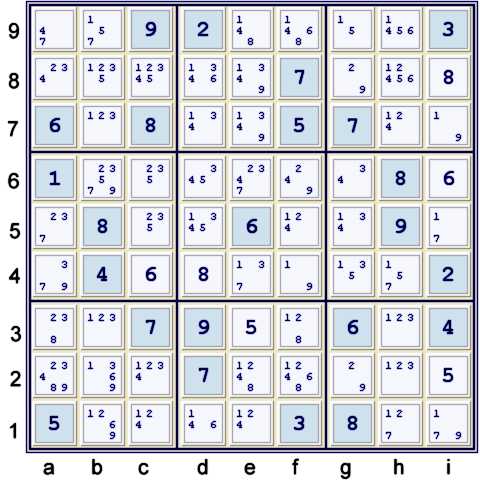The following is an illustrated proof for the
Tough Sudoku of February 20, 2007.
This is a very difficult puzzle to solve, unless one resorts to guessing.
This is page one of a multi-page proof for this puzzle. The pages will come out gradually over
the next few hours, as they are created. The general theme of each page will be slightly different,
as the puzzle progresses through various degrees of technique difficulty.
There are many ways to tackle this one. The primary focus of this proof is to illustrate
using Forbidding Chains, also called Alternating Inference Chains or AIC.
Some of the Chains that are presented are complex forbidding chains - or advanced forbidding chains.
Such chains merely use arguments that are Boolean variables (something that is either TRUE, or False).
Some of these Booleans represent
native puzzle conditions that are neither bivalue in a cell, nor candidates that are bilocation.
You may need to refer to previous blog pages to understand
this proof. Links to these pages are found to the right, under Sudoku Techniques.
At many times during this illustration, there are other steps available. It is not the goal
of this page to show every possible step, but rather to illustrate steps that, taken together,
unlock this puzzle. Some steps that are not required will be illustrated. The purpose of
illustrating such steps is primarily to clue the potential solver on how to decide upon a plan
of attack for truly diabolical puzzles.
The information on the following blog pages is required to understand this page:
The illustrations of forbidding chains used in this proof will share the same key:
- black lines = strong links
- red lines = weak links
- black circles connected with black lines = multi-part strong sets
- candidates crossed out in red = candidates proven false
Puzzle at start
A few Unique Possibilities are available here.
- i8 = 8% column & box
- d4 = 8% column
- i6 = 6% column
- c4 = 6% box & row
The puzzle, now advanced to UP 27, starts without any real indication of its extreme difficulty.
Some Locked 5s
Possible locations for 5 are highlit in green. One can proceed as follows:
- Locked 5s at e23 => e46≠5 or
- Locked 5s at f56 => e46≠5 then
- Locked 5s at gh4 => g56,i5≠5
This reveals the following
Unique possibilities:
- i2 = 5% column
- e3 = 5% row, column, & box
Hidden Pair 29
Typically, before entering the possibilities, Hidden Pairs are easier to find. The symmetrical
placement of 29 relative to column g reveals:
- Hidden Pair 29 at g28
- => g28 is limited to only 29
Locked 3s
Because of the hidden pair 29, one can perform either one of two equivalent locked
candidate eliminations with the 3s:
- locked 3s at h23 OR
- locked 3s at g456
In either case, h4≠3
Locked 4s
Once again, there are two equivalent ways to make the same elimination: g9≠4
- Locked 4s at g56
- Locked 4s at g789
Locked 9s
e46≠9 by either or both of:
- Locked 9's at f46
- Locked 9's at e78
Coloring on 2s
Possible 2s are highlit. The following coloring elimination can be presented as a
forbidding chain on 2s:
- b7 == h7 -- g8 == g2
- =>b2≠2
One could call this elimination a two string kite. One can also call the configuration in
box h8 and box h2 hinges. None of this is required to understand the elimination. Instead, it
is far more productive to think in terms of strong and weak links, as drawn above. In any event,
one can also view the chain as a proof by contradiction (All chains have an equivalent proof by
contradiction within the strong and weak sets considered):
- b2=2 => b7,g2≠2
- => g8 = h7 = 2
- but, g8,h7 share box h8, thus b2≠2
Rather than search for proofs by contradiction, I prefer to focus on the stuff that
All Sudoku Techniques are made from:
Strong sets.
Puzzle after the easy stuff

The possibility matrix above represents this puzzle after making all the indicated eliminations.
The typical easy eliminations are exhausted at this point. I recommend using a puzzle
mark-up of some sort to continue.
The idea behind a puzzle mark-up is rather simple: A puzzle is presented as a set of very strong
sets = cells defined as equal to exactly one candidate. There are 81 cells one has to solve. There
are 243 restrictions by location that one has to also comply with. The puzzle mark-up merely
makes these restrictions by location more obvious. It also serves as a potential strategy indicator.
The puzzle mark-up merely brings to fore the hidden strong sets = sets strong by location.
The next blog page will consider in some detail how to attack a puzzle based upon such markings.
Links to the next blog pages regarding this puzzle proof will become available as the pages
are produced. It is not certain at this time how long it will take for the production team to
create each page. It is believed that the illustrated stategy for proof will consume four blog
pages.